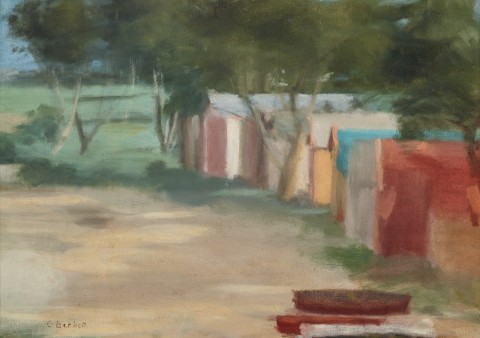BATHING BOXES, BEAUMARIS, c.1932
CLARICE BECKETT
oil on canvas
45.0 x 65.5 cm
signed lower left: C. Beckett
bears inscription verso: B / 43
Private collection, Melbourne
We are grateful to Rosalind Hollinrake for her assistance with this catalogue entry.
This idyllic painting depicts a quiet corner of Beaumaris, a coastal suburb to the south of the city of Melbourne. From the earliest days of colony, this bay-side locale attracted pleasure seekers with the first public swimming baths dating from the 1840s. By the turn of the century, clusters of bathing boxes were built within the ti-tree scrub by private individuals, or to service the patrons of nearby guesthouses. In Bathing Boxes, Beaumaris, c.1932, Clarice Beckett turns her gaze to one such group, most likely located in the cove of Watkins Bay, at the end of the street where the artist lived. Beckett’s distinctive style is immediately recognisable and, when seen collectively, her paintings provide an unsurpassed record of the changing landscape of the region.
The artist was raised in Casterton in regional Victoria but the family often holidayed at Beaumaris. Her mother Kate ‘had taken sketching and painting classes and counted among her friends Walter Withers and Ola Cohn.’1 On their advice, she enrolled Clarice (and her sister Hilda) in the National Gallery School in 1914, studying under Frederick McCubbin. Inspired later by a lecture by the artist-theorist Max Meldrum, she joined his school for a year. Meldrum taught his own theory of ‘optical science’ aka Tonalism, which, as its name implies, revolved around building an image based on tonal values alone. Although she remained within the Meldrumite orbit throughout her subsequent career, Beckett’s paintings were truly a combination of the Gallery School’s academic teaching, Tonalism – and herself. As her colleague Elizabeth Colquhoun noted, Beckett’s paintings were more ‘fragile’ than Meldrum’s. ‘It was a different kind of thing, but it was very truthful.’2
By the early 1930s, bathing huts could be found on all beaches in the area, sometimes two or three deep. In Bathing Boxes, Beaumaris, the depth of the shadows indicates that the artist painted it in the early morning, a time when she was free from the constraints of looking after her increasingly frail parents. With her hand-made painting trolley in tow, Beckett would wander the same areas repetitively, always approaching a scene with a different ambition as to the mood she wished to capture. Indeed, when asked why she never felt the desire to travel more widely, she responded ‘I have only just got the hang of painting Beaumaris after all these years, why should I go somewhere else strange to paint?’3 Rosalind Hollinrake, the historian who ‘re-discovered’ Beckett, included a near identical painting in her landmark exhibition Clarice Beckett: politically incorrect in 1999. The variant on offer here is a tighter composition, and includes the Beckett family’s own hut near the centre of the group. Also apparent is Beckett’s technique of putting ‘a bit of the colour of the object ... into its shadow’ thus giving the whole ‘a greater luminosity.’4
Ultimately, this idyllic scene no longer remains. A huge storm in 1934 (also captured by Beckett in a memorable sequence of paintings) destroyed bathing boxes up and down the coast, most of which were not replaced. Bathing Boxes, Beaumaris, therefore, remains as a significant memorial to the location, and to the artist herself.
1. Hollinrake, R., ‘Painting against the tide’, The Age, Melbourne, 3 April 1985, p.16
2. Elizabeth Colquhoun, cited in Peers, J., More than just gumtrees: a personal, social and artistic history of the Melbourne Society of Women Painters and Sculptors, Dawn Revival Press, Melbourne, 1993, p.197
3. Clarice Beckett, c.1928, cited in Hollinrake, R., Clarice Beckett: the artist and her circle, Macmillan, Melbourne, 1979, p.21
4. Clarice Beckett, c.1930, cited ibid., p.26
ANDREW GAYNOR
